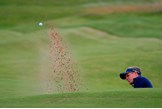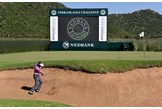Luke Donald’s 10 greenside bunker rules
Published:
Luke Donald, this month’s British Masters host shares his best tip for bunker success.
The former world number one got up and down from sand more than 60% of the time last year putting him inside the top 10 on the PGA Tour.
We caught up with the Englishman at The Grove in Hertfordshire where the venue for Donald’s British Masters, supported by Sky Sports.
TOP STORIES
Soft golf balls are closing the gap on premium balls
Game-Improvement Irons test 2016
1 My best tip to become a successful bunker player is to use the bounce on the sole of the club, and to use the bounce you need a good set-up. By that I mean putting the ball way forward in the stance, leaning the shaft backwards so you’re exposing that bounce and making sure that there’s loft on the clubface throughout.
2 You should take a full swing because you want to hit the ball as hard as you can – you want to create speed and that’s why you put the ball way forward in your stance, open the blade and expose the bounce: it allows you almost to glance the ball.
3 Obviously you’re not making direct contact with the ball, but taking shallow sand divots that ‘throw’ the ball out on to the green. That glancing impact is the result of hitting the sand with an open face – as opposed to the regular square face – and taking that shallow sand divot. As a result the ball comes out high with a lot of spin. The faster you hit it, the more spin you’ll create.
4 I believe amateurs should look to create a divot that is as much in front of the ball as it is behind. Most amateurs swing it way too inside and tend to catch the sand way too far behind the ball, so the ‘divot’ starts way back but finishes only just in front of the ball.

5 To be honest, it doesn’t really matter how far back the club first makes contact with the sand – the key is that the divot is the same at the front of the ball as behind. In fact really good bunker players have more of a divot in front of the ball than behind it.
6 Don’t forget, the takeaway needs to be smooth and shallow, but you need to make sure you don’t ever use the front edge of the wedge – the last thing you want to do is dig into the bunker and take big, deep divots.
7 After impact, let the club go with the followthrough, but re-hinge your wrists, keeping the loft on the clubface. You don’t want the clubface to rotate; instead, look to keep the blade square to the target – that keeps loft on the face as much as possible.

8 Personally, I like to throw the ball high with a lot of spin and land it most of the way to the pin. Obviously, the safer shot is to have it roll out a bit more, but the better technique you have, the more you will feel you can take thin, shallow divots and hit it high and soft so that when it lands, it stops pretty quickly.
9 Set your body angles to follow the slope. If you’re on a downslope make sure your spine is at right angles to the gradient to help you swing down the slope; don’t ever try to lift the ball up. It’s the same principle with an upslope or sideslope. Basically, you’ve got to judge the situation, weigh everything up… and don’t forget, sometimes just getting out of a deep bunker is a good shot!
10 Believe. And by that I mean be confident, positive and commit yourself to the shot in hand. Once you have worked out the right technique and practised, getting up and down should be a regular occurrence.
-
 Luke Donald of England plays a shot from a bunker on the 4th at the 145th Open Championship at Royal Troon
Luke Donald of England plays a shot from a bunker on the 4th at the 145th Open Championship at Royal Troon
-
 Luke Donald after holing out from a bunker for a birdie two on the 14th hole during the first round of the Northern Trust Open at Riviera Country Club.
Luke Donald after holing out from a bunker for a birdie two on the 14th hole during the first round of the Northern Trust Open at Riviera Country Club.
-
 Luke Donald plays from a greenside bunker on the 17th during the second round of the Nedbank Golf Challenge at the Gary Player Country Club.
Luke Donald plays from a greenside bunker on the 17th during the second round of the Nedbank Golf Challenge at the Gary Player Country Club.
